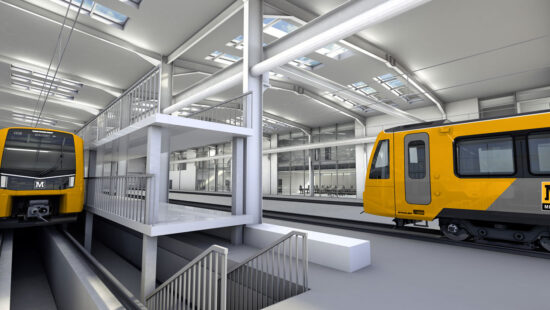As well as supplying a fleet of new trains to operate on the Tyne and Wear Metro network, Stadler have also been contracted to rebuild the main depot at Gosforth with VolkerFitzpatrick having been taken on to complete this work on their behalf. With work having started last year three depot roads and an area of the main depot building have now been successfully removed and attention will soon be turned to track foundation work as the project continues.
The existing depot site at Gosforth is being fully redeveloped to house the new fleet of trains being constructed by Stadler for use on the network from 2023. The programme to demolish the depot is being completed in four stages with the first stage also seeing work on the track beds with old tracks being broken up and removed in preparation for the laying of foundations for new tracks.
Work to build foundations for the new tracks will begin in June. This will involve boring hollow steel tubes into the ground and filling them with concrete. Foundation work on the main depot building will be carried out in July and the second phase of demolition – involving the removal of an old stabling shed to the west of the depot – will take place later in the year. The last two stages of the planned demolition will take place in 2022 and 2023 with most of the new depot completed in 2025.
During the first phase of demolition waste material has been crushed for recycling and will be used to build a road on the depot. This has helped to prevent the movement of thousands of tonnes of stone by road highlighting Stadler’s green credentials and a pledge to keep its carbon footprint to a minimum.
Neil Blagburn, Metro Development Director, said: “Excellent progress has been made getting the site ready for our new, £70m Metro fleet depot in Gosforth. The last few months has seen the partial demolition of the 100 year-old train shed, creating room to get the site ready for the new buildings and infrastructure. Approximately30 per cent, around four acres of the original depot’s sidings have been removed paving the way for the first foundations to start going in. The completed project will provide a modern new home for the new Metro train fleet. These are the first steps on a really historic journey that will secure the future of the Tyne and Wear Metro for many generations to come. Our thanks go to Stadler, VolkerFitzpatrick and Thompsons of Prudhoe for getting this phase of the project off to such a good start. The old depot buildings will be pulled down in phases over the next two years. We are storing up to a quarter of our current trains at our purpose built satellite depot in Howdon while the depot transformation takes place.”
The new depot on the 12 acre site will comprise inspection roads and pits, cranes, jacks, test facilities, automatic train-checking equipment and a wheel-lathe. It will also feature a wash-plant to clean train exteriors and other dedicated areas for both daily and periodic deep-cleaning. The outside area is set to be adapted to optimise train movements, while also keeping noise to a minimum for the benefit of local residents.
The working environment will be vastly improved and the depot is due to become home to a wide range of activities, including preventative and corrective maintenance, overhauls and train presentation. There will be storage for spare parts and material supplies and office space for training and support functions. All this will help to ensure maximum availability and reliability of the fleet for many years to come.
Rob Baxter, Managing Director of Stadler Rail Service UK, said: “The project to build a new depot has been configured to enable the existing trains to continue successfully operating from it, while construction takes place. This is a challenge, but I am delighted that the project has maintained momentum despite the pandemic, and that so much progress has already been made.”

